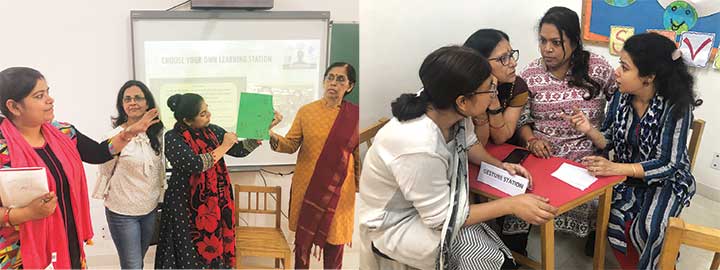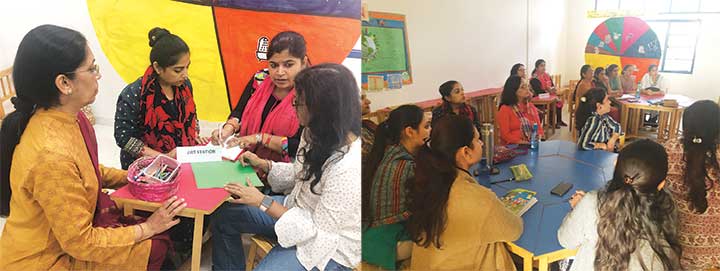Divya Kapoor
Assessment is an integral part of our curriculum, as it helps in determining whether or not the educational goals have been attained. In a traditional classroom setting, assessment focuses on identifying knowledge, skills, and attitudes that students have acquired via a lesson, course or grade. Designing an appropriate assessment is imperative as it inspires teachers to consider the differentiated needs of all learners, their preferred learning styles and pace, the flexibility that students are being offered and the learning gaps that might exist.
During the last decade, academicians have been calling for increased student ownership and bringing about flexibility in the assessment process. It is suggested that students and teachers should work collectively while deciding what to assess, when to assess, and how to assess. Furthermore, student feedback along with the teacher’s reflections should be taken into account while designing the assessments. However, the reality of today’s assessment practices is far from what is proposed.
It has been observed that students do not use assessment to improve their learning nor view it as feedback of their work. A simple rationale for this is that the assessment being administered is teacher-driven, rigid, and focuses only on accurate responses. As a result, students get disengaged, are less enthusiastic and do not draw much benefit from the teaching-learning process.
It is important to bridge the gap between the current assessment practices and our vision to nurture lifelong learners. Today’s learners should be given freedom to choose their assessment in terms of the mode, time and medium of assessment by using a fair, unbiased and flexible assessment system. This article focuses, on effective flexible assessment strategies that can be implemented in the curriculum and the imperative role of a teacher to provide students the autonomy to choose their mode of assessment.

What is flexible assessment?
The linguistic shift from the term integration to inclusion was introduced in the National Curriculum for school Education (NCFSE 2000) brought out by the NCERT. It recommended creating a learning environment that is child-centered, flexible and which enables children to develop their unique capacities in a way that is conducive to the individual styles of learning.
In simple words, flexible assessment is a student-driven assessment which involves students taking the onus of their own learning. Students can be offered flexibility in terms of the environment, theme, mode and time of assessment depending on their area of interest and comfort level. This student choice in assessment explores the idea of equivalent ways of demonstrating learning outcomes where students can use different methods to showcase their understanding. This freedom of choice that they are able to exercise makes them feel respected and so they begin to take ownership of their learning. On the other hand, incorporating flexibility in the assessment process turns out to be a plausible solution for a teacher to break the repetitiveness in the ongoing assessment system.
Implementing flexibility
Our students’ knowledge, skills and attitudes are built through learning experiences and opportunities in a teaching and learning program informed by a curriculum and delivered through the pedagogical and assessment skills of teachers. The current assessment system we follow is quite disengaging, primarily focuses on pen and paper tests and does not provide much room for flexibility. The question that arises is, ‘How can a teacher model flexibility in a typically rigid assessment system?’
Flexibility can become a part of our assessment process if teachers are open to experimentation and are willing to break the age-old stereotypes. Giving students’ a choice in their assessment requires maturity and self-knowledge of learning styles on the part of the teacher. The flexible assessments aim at designing activities that allow all students to choose the format of assessment that will enable them to express their ideas in the most equitable way.” (Neil Keating, Tanya Zybutz& Karl Rouse (2012): Inclusive assessment at point-of- design, Innovations in Education and Teaching International, 49:3, 249-256.)
Flexibility of this kind is intended to encourage students’ participation in the learning process, thereby promoting self-regulated learning skills. Such assessments can be designed by choosing a specific theme and providing students with an array of tools to showcase their learning. The flexibility in the assessment can be offered in terms of tools used, style of assessment, timeline of submission, content or topic, type of evaluation and feedback. The tools provided by the educators should cater to the preferred learning styles of the students thereby helping them achieve the intended learning outcomes.
For instance, how can we design a flexible assessment in mathematics for a topic like percentage and its applications? Students can be asked to research and find out about the economic growth trends in different states in India. Once they have collected the desired data, they may be asked to calculate the percentage increase/decrease observed. With a traditional assessment format, such an activity can be done in the form of a project, where the underlying purpose for a student is to demonstrate the collected data, calculate the desired percentage and deduce related inferences. Students may also ponder upon and present some reasons on the observed increasing/decreasing economic trends.

An alternative format (as per the students’ choice) can be to ask the students to accomplish this task using a web page, reflective blog, power point presentation, collage or a radio show. The teacher may design appropriate guidelines and rubrics to assess student work. Each student has his/her own strengths and weaknesses and such tasks provide students with an opportunity to choose their preferred learning style and pace. For many students, such inclusive assessments may prove a less difficult and more suitable way to show their learning. They also lay the foundation for deeper understanding of concepts and enhance student participation by making assessment a fun-filled process.
The marking of such assessments can also be made flexible. The work done by students can be assessed by the teacher and the peer; the peer and themselves or the teacher and themselves. Students may choose the mode of marking they are comfortable with. Involving them and their friends in the marking process further induces flexibility and removes the fear of assessment.
Conclusion
Building flexibility into the assessment process can provide students with autonomous learning experiences. This innovative approach of involving students in their own assessments will have a positive influence on their motivation, attitudes and grades. Teachers, on the other hand, get ample opportunities to harness the potential of their students by giving wings to their creativity. Thus, flexible assessment is a win-win situation where both the students and the teachers become the beneficiaries.
The author is the headmistress, Pragyan School, Greater Noida. She is a progressive teacher with an experience of 13 years. She has received the prestigious Global Teacher Award 2019 and CBSE National Award 2018 for her contributions in the field of education. She can be reached at divyakapoorx@gmail.com.
